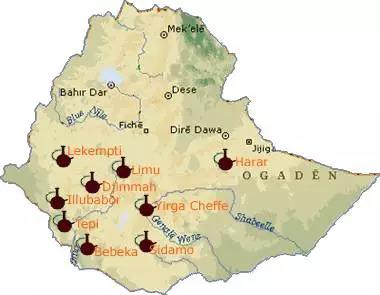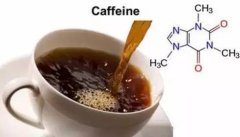Esseyga Sheffield Kochere Washed Coffee Bean Difference, Differentiation and Awards
For professional baristas, please follow the coffee workshop (Wechat official account cafe_style)
Cochel is located in a small producing area 25 kilometers southeast of Yegashafi, Ethiopia. It is a rich area for coffee production. It is also one of the three famous and micro-producing areas of Yegashafi. It has about 100,000 local residents, and coffee beans are the main source of income. The processing and processing equipment of this production area is very advanced. Coffee Review, a well-known coffee evaluation website, gave Kocher a high rating of 94 points for washed coffee beans.

There are eight main coffee producing areas in Ethiopia: Nekempte (Lekempti) Gimbi Kinby, Limulim, Illubabor Ibedo, Djimma Gima, Harrar Hara, Teppi/Bebeka Bebeca, Sidamo Sidamo and Yirgacheffe Yega Chefe. Among them, the more well-known boutique coffee producing areas are Nekempte (Lekempti), Limu, Harrar, Sidamo and Yirgacheffe,Yirgacheffe Yega Chefe located in the Sidama region of Ethiopia, so it can be seen that Yirgacheffe belongs to the smaller area of the Sidama producing area.
Yega Xuefei's grading system is not based on the number of eyes, but on the proportion of defective beans in the total number of raw beans. Commonly seen are wash G2 and sun G3 Yega Chuefei, G1 is the highest grade, Yega Xuefei, which has the lowest defect rate and the best quality, can be rated as Grade 1 only after hand selection.
Yejaschuffe itself is a small town of about 20, 000 people, and the three neighboring producing areas, Wenago, Kochere and Gelena Abaya, are also classified as Yejasuffe because they produce coffee with almost the same flavor as Yejasuffe. Yejacheffe is similar to the neighboring Sidamo in terms of culture and geography, but it seems to be more favored to enjoy the advantageous conditions, top-quality Yega Chefe coffee with floral aromas, bright citrus acidity, lemon flavours and silky taste.

Kochere Cochel is located in southwestern Ethiopia, 25 miles north of the famous town of Yega Chefen. The production model is based on local small farmers sending output batches to cooperatives for unified processing. The local Chalalacktu village has about 100000 people who depend on coffee for a living, and related production activities have become their main source of income. Due to the benefits brought by coffee production, the local living standard is much better than that in many Ethiopian villages, with sound health facilities, colleges and universities, and so on. Advanced processing equipment makes the coffee in the Kochere area always have a high level of performance in the field of washing treatment, with the clean and sweet complex flavors of molasses and citrus.

Country: Ethiopia
Grade: G1
Producing area: Yejia Xuefei Kochel
Baking degree: shallow baking
Treatment: washing
Variety: native species
Flavor: Jasmine, lemon, bergamot, honey, black tea

Hand-washed Yejia Sheffield Kochel. 15g powder, medium fineness grinding (small Fuji ghost tooth cutter 3.5grinding), V60 filter cup, 90mur92 degree water temperature, first water injection 30g water, carry on steaming for 27 seconds, injection to 105g water cut off, wait for powder bed water volume to half, then water injection, slow water injection until 225g water volume, no water powder ratio at 1:15, extraction time at 2:00
Country: Ethiopia
Grade: G1
Producing area: Yejia Xuefei
Baking degree: shallow baking
Treatment: washing
Variety: native species
Important Notice :
前街咖啡 FrontStreet Coffee has moved to new addredd:
FrontStreet Coffee Address: 315,Donghua East Road,GuangZhou
Tel:020 38364473
- Prev

Flavor characteristics, producing area and brewing ginseng of coffee beans washed by Esseyega Ficochel kochere
Professional baristas please follow the Coffee Workshop (Wechat official account cafe_style) Yejaschafe itself is a small town of about 20, 000 people, the three neighboring producing areas Wenago, Kochere and Gelena Abaya, because the flavor of the coffee is almost the same, so it is also classified into the Yejashaffe area. Yega snow caffeine, whether it's culture or
- Next

Chateau Kimmel, Papua New Guinea PB round beans, boutique coffee beans, brand recommendations and estates
Professional baristas please pay attention to the coffee workshop (Wechat official account cafe_style) now I would like to introduce to you the full name Peaberry of PB, that is, round beans, usually with two seeds in a coffee fruit, that is, our common coffee beans, which are curved on one side and flat on the other, similar to the shape of peanuts, which we call flat beans; round beans are in a coffee fruit.
Related
- Detailed explanation of Jadeite planting Land in Panamanian Jadeite Manor introduction to the grading system of Jadeite competitive bidding, Red bid, Green bid and Rose Summer
- Story of Coffee planting in Brenka region of Costa Rica Stonehenge Manor anaerobic heavy honey treatment of flavor mouth
- What's on the barrel of Blue Mountain Coffee beans?
- Can American coffee also pull flowers? How to use hot American style to pull out a good-looking pattern?
- Can you make a cold extract with coffee beans? What is the right proportion for cold-extracted coffee formula?
- Indonesian PWN Gold Mandrine Coffee Origin Features Flavor How to Chong? Mandolin coffee is American.
- A brief introduction to the flavor characteristics of Brazilian yellow bourbon coffee beans
- What is the effect of different water quality on the flavor of cold-extracted coffee? What kind of water is best for brewing coffee?
- Why do you think of Rose Summer whenever you mention Panamanian coffee?
- Introduction to the characteristics of authentic blue mountain coffee bean producing areas? What is the CIB Coffee Authority in Jamaica?

